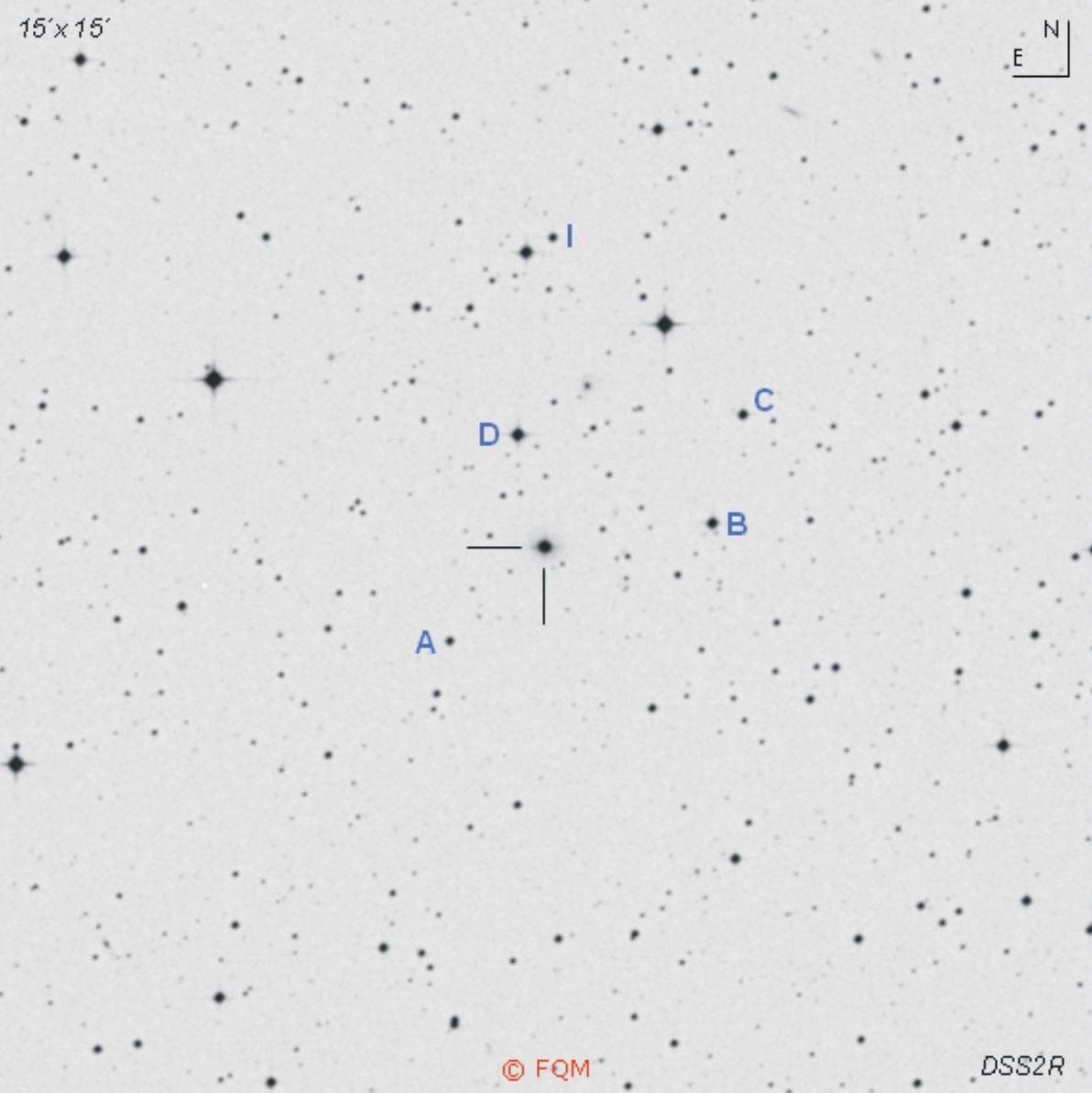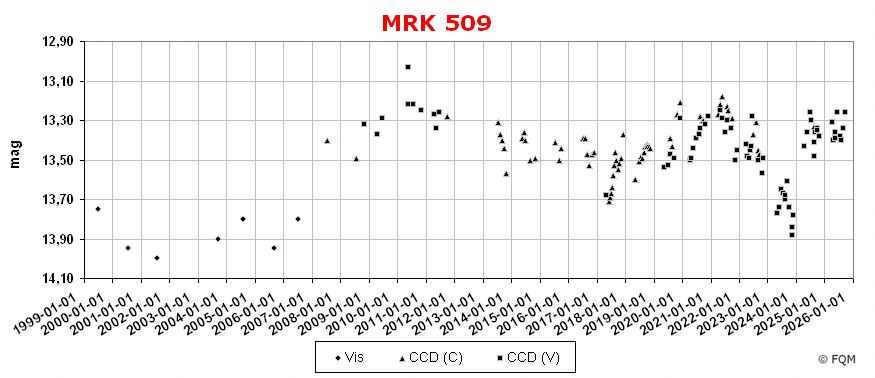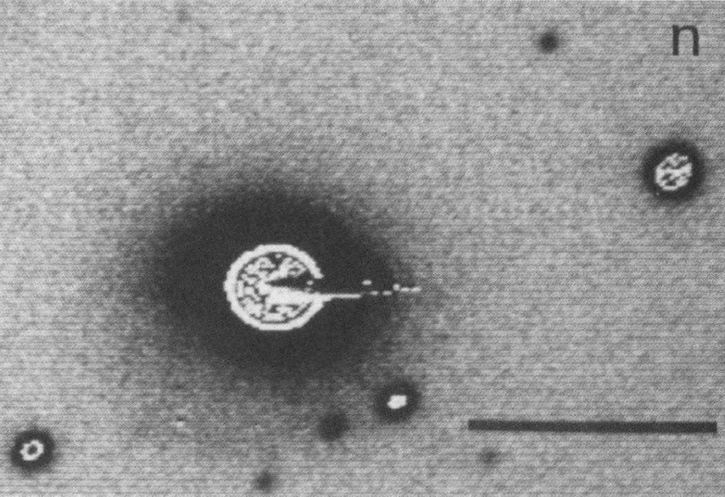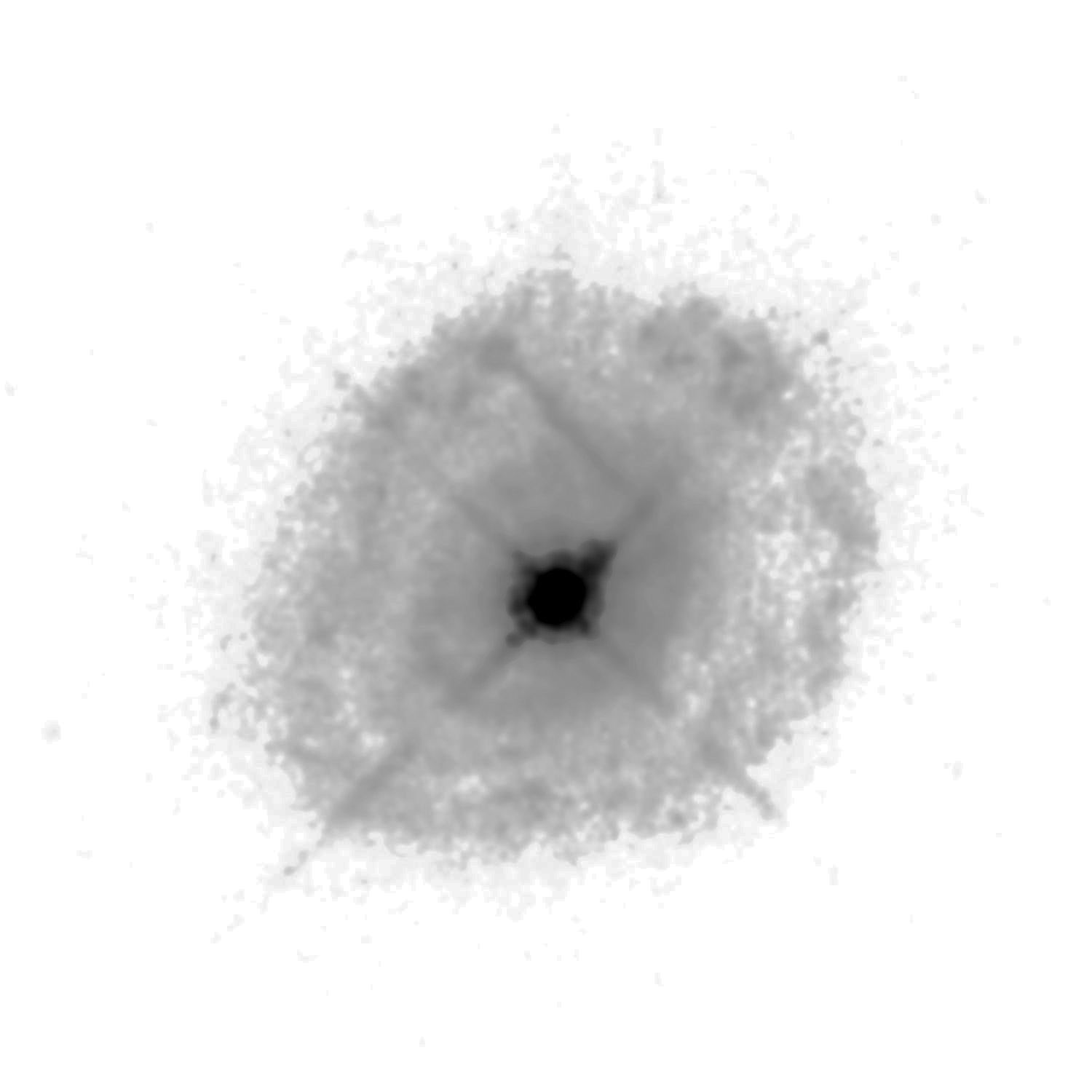
| Frankfurt Quasar Monitoring |
| MRK 509 |
| Cross-Identifications | IRAS 20414-1054, PGC 65282, 1H 2041-108 XSS J20441-1042, 1RXS J204409.9-104330 1XMM J204409.8-104326, QSO B2041-109 2MASS J20440975-1043246, 2A 2040-115 RX J204409-10435, SWIFT J2044.3-1045 |
| Equat. coordinates | RA 20 44 09.7 DE -10 43 24 (J2000) |
| Constellation | Aquarius |
| Type | QSO |
| Redshift (1) (5) |
z=0.035 |
| Distance (2) (3) |
136 Mpc |
| Total mag range (mv) (4) | 13.1 - 14.8 |
| Catalog Magnitude (1) | 13.12 |
| Absolute Magnitude (1) | -23.3 MB |
| Light Travel-Time (2) | 0.438 × 109 yrs |

Comparison stars
| star | V | B-V | U-B | V-R | R-I |
| A | 14.54 | 0.67 | 0.17 | 0.35 | 0.36 |
| B | 13.12 | 0.55 | 0.00 | 0.32 | 0.31 |
| C
var |
14.02 | 0.98 | 0.61 | 0.60 | 0.55 |
| D | 12.41 | 0.57 | 0.09 | 0.32 | 0.31 |
| I | 14.43 | 0.59 | -0.03 | 0.37 | 0.37 |

 Fig. 1
|
 Fig. 2
|
| Markarian 509
(MRK
509 for short) is a bright
quasar in south-western Aquarius, close to the constellation Capricornus. MRK 509 was discovered in 1973 as a B=13 mag compact
object by the
UV-Continuum- Survey run by Markarian et al. (MRK), searching for blue
galaxies with excessive UV-emission. Follow-up spectroscopic
investigations in 1974 revealed a Seyfert 1-spectrum, which led to the
quasar classification. At a distance of only about 400 million
light-years, MRK 509 is one of the nearest quasi-stellar objects known.
Since 1975, quasar MRK 509 has been noticed as an infrared source,
further investigated by IRAS in 1983 and the 2 Micron All Sky Survey
(2MASS).
As a radio source, this quasar was first
detected in 1976. MRK 509 is also known as one of the brightest
X-ray AGN in the sky, first detected in
1974-1976 by the 2. Ariel V-Survey (2A). Further X-ray investigations
were carried out by HEAO A-1 (1H), ROSAT (RXS), EXOSAT and SWIFT. A hint of the quasar host can be seen in the finding chart above. The host galaxy appears as a star-like object (QSO), enveloped by a diffuse circular halo of about 10”× 8”. However, deep high resolution photographs in the optical revealed a much larger extension and an asymmetric halo to the south (see Fig. 1). As there is no neighbouring galaxy found close by, this asymmetric halo is an indication for a strong interaction in the recent past. In addition, an image by the Hubble Space Telescope (see Fig. 2) shows a ring-like feature around the galaxy core, that possibly represents an irregular starburst ring with an outer radius of <2 kpc. This advanced stage of merger has most likely triggered the strong AGN activity of MRK 509. The central powerhouse of MRK 509 is a supermassive black hole of approximately 3×108 solar masses. In the optical, the quasar host appears very compact and shows an amorphous optical morphology. Perhaps, we see a disturbed and slightly tilted face-on disk galaxy, probably of type S0. The published data on the apparent size of the quasar host are inconsistent. For clarity, the author did some measuring from optical inspection of a deep CCD image in V-band, published by MacKenty (1990) (see Fig. 1). Combined with the scale reference given by NED, the resulting true size of the main galaxy body of the quasar host is about 160×115 klyrs. This is a factor of 7.7 times the size published by Markarian et al. (1973). Including the asymmetric halo to the south, the overall true size increases to about 182×160 klyrs. Quasar MRK 509 is a weakly variable object with a total range of nearly 2 magnitudes in the optical. This object is an attractive target for visual observers with at least an 8-inch telescope or larger. Medium size telescopes show MRK 509 as a stellar object. In large instruments, MRK 509 becomes increasingly star-like with a very faint outer halo. CCD observers, as well as visual observers, shall use the comparison stars given above. Other photometric sequences were published by Doroshenko et al. (2005), Hamilton et al. (1978), Miller (1981), and the BAAVSS. ____________
Quasar MRK 509 is located in south-western Aquarius, close to the constellation Capricornus, and only 1.5° SW of Epsilon Aqr. Two deep sky showpieces around MRK 509 are worth visiting. First there is M72, a bright 9.3-mag globular cluster only 3° to the south-east. A 10-inch telescope will resolve about 20 faint stars of this globular, located about 60 000 light-years away from earth. The second object is NGC 7009, the "Saturn-Nebula", a prominent planetary nebula, located some 5° to the east. Through the eyepiece, NGC 7009 appears as a tiny blue-green oval disk of 30"×26", which responds well to both UHC- and O-III filters. |
| Allen, D.A. 1976, ApJ, 207, 367; The near-infrared continua of emission-line galaxies. Biermann, P.L., Schaaf, R., et al. 1992, A&AS, 96, 339; X-ray observations of flat spectrum radio sources with the HEAO-A, Einstein and EXOSAT observatories. Cooke, B.A., Ricketts, M.J., et al. 1978, MNRAS, 182, 489; The Ariel V (SSI) catalogue of high galactic latitude (I b I >10°) X-ray sources. Darling, G.W., Wegner, G. 1994, AJ, 108, 2025; Spectral types for objects in the KISO survey. IX: Data for 121 objects. de Grijp, M.H.K., Miley, G.K., Lub, J. 1987, A&AS, 70, 95; Warm IRAS sources - A catalogue of AGN candidates from the Point Source Catalogue (PSC). Doroshenko, V.T, et al. 2005, Ap, 48, 304; BVRI CCD-Photometry of comparison stars in the neighborhoods of galaxies with active nuclei. II Hamuy, M., Maza, J. 1989, AJ, 97, 720; UBVRI photoelectric photometry in the fields of fifteen active galaxies. Kaastra, J.S., Petrucci, P.-O., et al. 2011, A&A, 534, A36; Multiwavelength campaign on Mrk 509. I. Variability and spectral energy distribution. Karge, S.; Helle Quasare für 8- bis 10-Zoll Teleskope. Ein Beobachtungsführer zur visuellen Beobachtung von Quasaren und BL Lacertae Objekten; Frankfurt 2005. Kriss, G.A., Arav, N., et al. 2011, A&A, 534, A41; Multiwavelength campaign on Mrk 509. VI. HST/COS observations of the far-ultraviolet spectrum. Kühr, H., Johnston, K.J., et al. 1987, A&AS, 71, 493; Optical Identifications and Radio Morphology of the complete 5 Ghz S5 Survey. Kühr, H., Pauliny-Toth, I.I.K., et al. 1981, AJ, 86, 854; The 5-GHz strong source surveys. V - Survey of the area between declinations 70 and 90 deg. MacKenty, J.W. 1990, ApJS, 72, 231; Seyfert Galaxies. I - Morphologies, Magnitudes, and Disks. Markarian, B.E., Lipovetski, V.A. 1973, Astrofizika 9, 487; Galaxies with Ultraviolet Continuum. VI Markarian, B.E. 1977, A&A, 58, 139; On the nature of galaxies with UV continuum having broad emission lines. Mehdipour, M., Branduardi-Raymont, G., et al. 2011, A&A, 534, A39; Multiwavelength campaign on Mrk 509. IV. Optical-UV-X-ray variability and the nature of the soft X-ray excess. Stein, W.A., Weedman, D.W. 1976, ApJ, 205, 44; The origin of ultraviolet and infrared continuum radiation from Seyfert galaxies. Steinicke, W.; Beobachtungsliste für helle Quasare; Umkirch 1999. Véron-Cetty, M.-P., Véron, P. 2001, A&A 374, 92; A Catalogue of Quasars and Active Nuclei: 10th edition. Véron-Cetty, M.-P., Véron, P. 2003, A&A 412, 399; A Catalogue of Quasars and Active Nuclei: 11th edition. Véron-Cetty, M.-P., Véron, P. 2006, A&A 455, 776; A Catalogue of Quasars and Active Nuclei: 12th edition. Véron-Cetty, M.-P., Véron, P. 2010, A&A 518, 10; A Catalogue of Quasars and Active Nuclei: 13th edition. Wegner, G., McMahan, R.K. 1988, AJ, 96, 1933; Spectral types for objects in the KISO Survey. IV - Data for 81 stars. |
| Links: Chara/PEGA MRK 509 (Sasmirala, Univ. of Heidelberg) BAAVSS |
| home |